

Goals for calf rearing
How calves are reared will set the tone for the lifetime productivity of the animal. Well-reared calves will be an asset to the herd.
Whether rearing calves for heifer replacements or beef animals, goals are similar:
• To develop the rumen of the calf (which is immature at birth), so that when it is weaned it can get nutrients from eating high fibre feeds such as grass.
• To produce quality replacement heifers that become high producing cows and will last over time in the herd.
• To grow beef animals to target weights faster and in better condition so they achieve slaughter dates earlier, or on time, at better weights.
• To do both in a way that is both cost effective and without compromising of animal well-being.
• Achieving calf rearing goals also includes taking a dairy industry by-product and producing it for niche markets in a best practice calf rearing system that is affordable and well managed.
Every calf counts

The Kiwi challenge
Calves in New Zealand tend to face more challenges than the average calf in other countries due to many factors.
• The tight calving pattern of the New Zealand dairy herd and large herd sizes means that a high number of calves are reared in a short period of time, which can put pressure on both the calves and staff.
• Calves are often reared in groups, compared to overseas calf rearing methods, which can have calves in individual pens. Group housing can increase the risk of disease spreading and can put more stress on the smaller calves in a pen. Calves may also be removed from the main calf sheds earlier than preferred due to limited spacing.
• Cows in New Zealand calve outside in often variable spring weather, which means that calves can be born into a wet, cold, muddy environment and initial colostrum intake can be depressed by these environmental factors.
• Cows in New Zealand are often wintered on crops that may not be well balanced in terms of energy, protein, trace elements and minerals, which can impact on nutrition to the foetus in late pregnancy, colostrum quality postcalving, and ease and speed of calving.
• The New Zealand herd has a significant portion of Jersey genetics, which produce lighter calves with poorer cold tolerance than black and white calves.

Calf selection
Selection of calves for rearing is important as it determines how successful the calf operation will be. It is best to avoid calves that are hindered from the start, as these calves will tend to be the poor-doers and will lag behind their age group.
Top tips for calf selection
• Buy from a reputable farmer if purchasing calves in and try and buy from as few sources as possible.
• Ensure calves have been fed sufficient colostrum of the right quality soon after birth. If you are unsure if calves have received adequate colostrum, there are tests available to check the levels of immunoglobulins in the blood — contact your local veterinarian for more details. If you have excessive calf health issues every year, it may be a good idea to look into this — particularly if you are purchasing the calves at 4 days old and have no control over the colostrum intake in those important first few days of life.
• Check that no navels are infected — check for swollen navels. The navel should be dry and shrivelled.
• Ensure calves are strong and bright — ears should be alert and not droopy and eyes should not be sunken (this indicates dehydration).
• Ensure calves have a good suck reflex.
• Ensure calves are not lame or sick.
• Try and stay away from rearing calves from twins or premature born calves.
• For heifer rearers, early born calves may not be the best animals genetically as later calving cows tend to be the higher producing animals. Rather than rearing the first born calves, it may be more beneficial to select calves throughout the calving period.
• If buying calves in, ideally buy calves from farmers who take active steps to minimise disease threats such as rotavirus.
• Do not purchase calves under 4 days old.
• Make sure calves are able to stand and bear weight evenly on all 4 limbs.
• Calves’ hooves should be firm and worn flat, not bulbous with soft unworn tissue.
• Try and buy locally as much as possible to minimise transport stress.
• If you are paying a premium price, make sure you are getting premium calves.
Following
these guidelines will mean that sick and unhealthy calves are avoided from the start. These calves would only cost money and reduce the overall profitability of calf rearing.”

Calf transportation
Care should be taken when transporting calves. The less stress calves experience during transport, the healthier they will be on arrival. Bruising of the navel during transport can encourage navel infections, which can develop into joint ill. Take care of calves and handle gently to avoid this.
Top tips for transporting calves
• If transporting calves straight off mum to the calf sheds, spray navel cord with minimum 7% tincture iodine before and after transport.
• Any calf trailers used must be cleaned, disinfected daily and bedding material kept dry.
• There should be sufficient room for all calves to lie down.
• Ensure there is a protective cover on the floor, such as hay, sawdust or a soft mat. This will ensure animals are kept warm and will also reduce injury.
• Protect calves from wind chill, rain and keep them as warm as possible.
• Avoid overfeeding prior to transporting.
• Educate carriers about low stress handling techniques.
• Feed electrolytes for the first 12 hours after delivery if they have travelled a long distance.
• Drive smoothly and carefully.
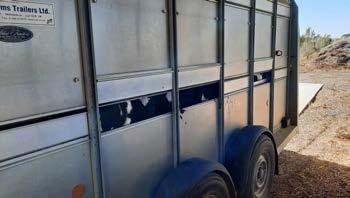
NAIT guidelines/tagging
When purchasing your calf either direct from a farmer or from a sale yard there are some rules around identification that by law is required, even if you are only purchasing 1 or 2 calves for your lifestyle block.
What do I need to do?
Calves must be registered in the NAIT system within seven days of being tagged or before moving off-farm, whichever is sooner. All animal movements must be recorded with NAIT, including confirming receiving movements within two days of the movement start or movement end date. All animal deaths or missing animals must be recorded with NAIT within two days of occurring, once in the NAIT system. You can contact NAIT to register.
Email: info@ospri.co.nz
Phone: 0800 482 463
Website: www.ospri.co.nz
Tagging
NAIT tags are the only tags required by law. Animals only need one NAIT tag each. You don’t need to tag an animal with your own NAIT tag if it already has one. Calves less than 30 days going directly for meat slaughter do not need a NAIT tag, but require an issued tag by the meat processor.
Once you are registered with NAIT, the next step is to buy tags for your animals. You can order through your local farm supply store.
To avoid ears getting infected check that the tagger is working correctly and the pin is straight and lines up with the upper jaw of the tool. When the tag is loaded check that they will align correctly, make sure your calf is restrained securely. Make sure the ear location is clean and before tagging your calf, dip the tags in the applicator into antiseptic or disinfectant before tagging the ear.

Tips for applying tags
• Correct tag placement ensures maximum retention and visibility.
• The tag should be applied between the two main ear cartilages and approximately half way between the head and the outside tip of the ear.
• Tags should always be applied with the male tag being inserted from the back of the ear as this increases retention.
• Always apply the tags firmly and quickly with one smooth positive action.
• Ensure you follow the supplied tagging instructions.
• Use the correct applicator as indicated by the instructions.
• Ensure tags are positioned correctly in the applicator.
• To lower the risk of infection and where possible tag during a dry weather event. This allows the wound to dry and heal more efficiently.
• If using disinfectant please ensure that it is at the correct manufacturers ratio.

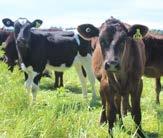

Calf housing
To get the most out of calves, it is essential they are provided with good housing. Poor comfort increases energy demand and stress, which results in reduced performance and immune response.
Young calves are born with very little fat reserves to use to keep warm, so they are susceptible to the effects of wind and rain. Calves should ideally be sheltered inside for at least 3–4 weeks after birth as cold, wet calves will put their energy into staying warm rather than growing. Calves can be moved outdoors at 3–4 weeks old but should still always have access to shelter from wind chill and draughts e.g. thick hedging, large straw bales or covered shelter.
Keeping calves free from thermal stressnot too hot or too cold, but warm and dry will prevent them from shivering — which increases energy demand and depresses growth rate. Friesian calves start to shiver at 3°C when dry and 13°C when wet. For jersey calves, this can be around 8°C if dry and 18°C if wet. When calves are out at grass, calf covers can be a good option to keep out the wind and rain and this can be particularly beneficial in exposed surroundings.
Guidelines for calf housing
• A calf shed with separate pens is necessary. The rule of thumb is 10–12 calves per pen, with an extra pen specifically for sick animals.
• Allow adequate space for calves — at least 1.5–2m2 per calf.
• Keep calves in groups according to age and/or fast and slow drinkers where possible, this will minimise bullying and stress, meaning calves will be healthier and will grow faster.
• Dry, draught free pens with good daylight exposure are best. If you can feel a draught on the back of your hand at calf level, it’s too draughty.
• Supply fresh clean running water in troughs at a reachable calf height, preferably set to the front of pen and not where animals sleep.
• Pens should be constructed with three solid walls using sheet metal or untreated plywood, with one end open to allow good ventilation and the removal of gases and ammonia from urine. This open end should ideally face leeward and north for sunshine.
• Pens should be twice as long as they are wide to allow calves to move to the back to get out of wind and rain.
• Ideally the floor should be coarse gravel, sand or small stones and have adequate depth of drainage.
Calf husbandry
Attention to detail goes a long way when it comes to calf rearing and taking the time to assess calf behaviour and health each day can be very beneficial in terms of calf survivability and productivity.
Calves should have a daily routine, with the same person feeding them every day if possible and at the same time each day. The calf rearer should be quiet and relaxed as this will reduce stress for calves and they will be more likely to drink their share of milk. The rearer should have plenty of time to do their job and complete their daily checks, as it is important that no part of the rearing programme (feeding, cleaning or animal health) is overlooked and that any problems are not unnoticed or put off.
Top tips for caring for calves
• In the first 12 hours of life the calf should have at least 10% or more body weight of good quality, day one colostrum (see colostrum section for more detailed information).
• If possible, pick up calves as soon as they are born. Getting them into the calf shed fast will ensure they are not cold for an extended period of time and will ensure they get the colostrum they require quickly.
• Don’t be afraid to stomach tube calves as required if they don’t willingly drink their required volume of colostrum or milk. Going off their milk feed can indicate sickness, so keep your eye on these calves and tube them again next feed if required.
• Always feed calves in the following order: young through to eldest, with calves in sick pen last of all.
• Calves should have their navels sprayed with at least 7% tincture iodine and checked regularly. If at 3 days of age the cord is bigger than a little finger, then it will require veterinary attention.
• Bring milk to the calves where practical, not the other way around. This will ensure calves are as relaxed as possible at feeding time.
• Make clean water available at all times.
• Take time to observe your calves’ behaviour so you can pick up on the slightest change – the earlier you intervene with sick calves, the better.
• Keep records to help identify problems. You may be able to trace problems back to events, or it may help you in future seasons.
• Always have Reliance Blue Boost electrolyte on hand and try and use it in a proactive way as much as possible. For example, use an electrolyte to aid hydration and reduce leaky gut or disease risk after transport, or during times of other stress. Be the fence at the top of the cliff rather then the ambulance at the bottom of it. If you can identify calves that are heading towards a sickness and get electrolyte into them sooner rather then later, you will be surprised at how much you can prevent issues developing.
Colostrum
It is crucial that calves receive high quality colostrum on their first day of life - preferably within the first 6 hours after birth. Because calves are born without having their own protective or ‘active immunity’, they have a high risk of infection until this develops with age. Calves that do not receive adequate immunity in the crucial period in early life will be on the back foot from day one and may be more likely to get sick and have poor growth.
Colostrum is important for new born calves as it contains high levels of immunoglobulins (IgG), otherwise known as antibodies. These are large protein molecules that are absorbed by the immature gut and provide passive immunity to help calves fight off infections for the first month of life and partially up to 6 months of age, while the immune system of the calf develops. There are 5Qs to remember when it comes to colostrum. Get all your 5Qs right and you will have calves in a good position to fight off the health challenges they may be exposed to in the first few months of life.
1. Quickly
It is crucial to get sufficient levels of colostrum into calves quickly in the first day of life, as after this the gut begins to lose the ability to absorb the IgG. After 24 hours no antibodies will be absorbed into the bloodstream from the calf’s gut. It is best to feed colostrum within the first few hours of birth and feed the total quantity of colostrum they require optimally within 6-8 hours of birth to ensure highest absorption of IgG.
It is important to remove calves from cows
as soon as possible after birth to ensure colostrum is received quickly — do not rely on calves getting colostrum from their mothers following calving, always assume they have not received any.
2. Quantity
The quantity of colostrum consumed by calves is crucial. Calves must consume enough colostrum in order to absorb enough IgG. However, quantity is closely linked to colostrum quality and more of a lower quality colostrum needs to be fed in order to satisfy IgG requirements. Typically, the total volume of colostrum required is 10-15% (2-4 litres depending on body weight) of birth weight, so larger calves will need more colostrum than smaller calves. Recommended levels of colostrum are dependent on the IgG level in the colostrum. It is recommended that a calf receives a minimum of 100g IgG within 6-8 hours of birth. Ideally this would be through either suckling or by using a stomach tube.
3. Quality
Quality is another extremely important factor when it comes to colostrum. High quality colostrum will have a higher concentration of IgG and therefore calves will absorb more immunoglobulins when it’s consumed. With very poor quality colostrum that has low IgG levels, calves can often not drink enough colostrum to satisfy their IgG requirements. Ideally, colostrum should have an IgG level higher than 50g/L and have low bacterial count. Colostrum is best fed at body temperature (38.5 - 39°C) to ensure optimum IgG absorption.

Feed colostrum at an optimal temperature: Not too hot, not too cold, just right, 38-39°C is optimal
4. sQueaky clean
Avoid bacterial contamination. Keep all buckets clean and covered to avoid any bacterial contamination with harmful bugs that can be passed onto calves.
5. Quietly
Always handle calves quietly and gently. A stressed calf is not as good at absorbing IgG across the gut wall.
The Five Qs of colostrum
Quickly — within 6-8 hours of life
Quantity — 4-6 litres depending on size of calf
Quality — lgG level >50g/L
sQueaky Clean — avoid contamination
Quietly — calm, quiet handling
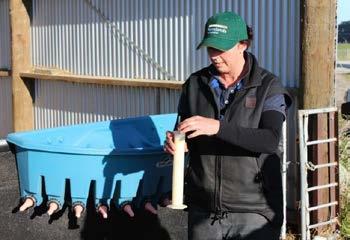
Optimal calf well-being
It is important that calves are raised with high standards of welfare, including caring for their physical and psychological health. Calves should be housed in a comfortable environment and kept injury free as then they not only feel and eat better, they grow faster.
• Always handle calves gently, quietly and calmly as they have soft bones/ joints that are easily damaged.
• Always check pens and remove any sharp objects/surfaces, and avoid slippery floor surfaces to prevent injury.
• Always house in optimal quality shelter to ensure correct temperature - not too hot or cold, and with proper ventilation.
• Plan ahead, identify and source required equipment, train everyone how to best check competently and confidently manage sick calves, or apply any animal health interventions.


• Have a hygienic facility that will minimise exposure to bacteria and viruses. Use a Broad-Spectrum disinfectant such as Virkon®S. A regular routine to clean and disinfect the shed, water troughs, feeders and surfaces.
• Have limited people through the calf shed. Try to keep the same person feeding the calves each day at the same regular time. Have footbaths and a sprayer with Virkon®S available to spray clothing and equipment before and after contact with calves.
• Always wash hands with soap and warm water before and after handling calves, feed and feeding equipment.
• Keep sick calves in a separate pen away from others.
• Keep hygiene foremost when handling sick calves including dedicated equipment.
• Situate the calf barn away from cows and dairy effluents. Cows can be carriers of disease.
• Keep bedding topped up to prevent odours and dampness that builds up.
Put together a management plan and keep careful watch on all calves, intervening early if calves are not doing well or showing signs of illness.
Attention to detail and early observation will reduce the impact of health issues and the chance of spreading infections to other calves. Twice daily observations by the same person (for consistency) is the gold standard.
Signs that could indicate a sick calf
• Droopy ears, head down, unresponsive to environmental noise.
• Refusing to drink the milk feed/coming on and off the teat/slow feeding
• Calves that are cold to the touch
• Standing apart from the group
• Abnormal rectal temperature (normal range is 38.5-39.4oC)
• Grunting, whistling or coughing
• Panting, rapid and increased breathing rate.
• Abnormal dung (see scours section)
• Lethargy/weakness
• Sunken eyes/hydration skin test (skin slow to flatten when pinched)
• Reluctance to stand
• Dull, rough, starry coat
• Poor growth
• Nasal discharge
• A run to the eye
• Teeth grinding/salivation
• Kicking tummy/unsettled and getting up and down a lot
• Swelling of the navel and/or joints, walking with a stiff gait

Signs of a healthy calf
• Bright eyed and alert
• Head up, ears pricked and following noise with ears
• Interactive with environment -visual/sounds
• Breathing quiet and effortless
• Shinny, groomed, and supple hair coat
• Even gait, move freely, playful behaviour.

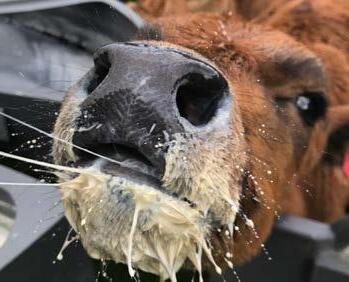

Scours
Scouring (diarrhoea) is the most common health issue seen in calves. There are two types of scours seen in calves — nutritional and infectious.
Nutritional scours
Nutritional scours most commonly occur due to dietary changes that are made too rapidly, environmental stressors and/or feeding setup issues, for example worn teats or feeding habit, (keep a ‘u-shape’ in neck’). Nutritional scours are not contagious, but can quickly lead on to more significant health issues as immune function can be compromised during the scour period. However if a nutritional scour is caught early and treated promptly with electrolytes, calves should ‘pop back up’ quickly with no issues.
Prevention:
Calves should not be overfed, diet changes should be made slowly and good quality milk or milk replacers should be used.
Make sure milk powder is mixed to specifications and that warm water used isn’t too hot. (Drinking temp should be 38-39°C). Be consistent in always feeding milk at the same temperature.
Calves should be fed at the same time each day, by the same person if possible.
Calves should be fed using teats that induce natural suckling behaviour to stimulate closure of the oesophageal groove and direct milk into the right stomach compartment.
Use new teats each season – worn teats can cause feeding issues and harbour harmful bacteria.
Infectious scours
Can be caused by bacteria (E.coli and salmonella), protozoa (coccidia and cryptosporidium) and viruses (coronavirus and rotavirus). Infectious scours are contagious, with transmission from calf to calf via faeces, urine, saliva and secretions from the eye, mouth and nose. It’s best to consult your veterinarian when confronted with infectious scouring to ensure targeted effective treatment.
Prevention:
Ensure good colostrum management so calves have good immunity.
Maintain strict hygiene procedures — cleaning equipment and pens regularly with an effective disinfectant.
Keep calves warm and in a draught-free environment.
Run a hygienic facility with good processes in place/ refresh bedding regularly
Put new calves into their own pen and don’t mix them with older groups if possible.
Look out for:
Loose, watery, bright yellow or green dung with a strong odour. Can be mucousy (however, don’t rely on dung appearance alone to identify what the issue may be –take faeces samples if worried.)
Blood in the dung (may indicate coccidiosis, salmonella, or coronavirus infection).
Coccidiosis
Coccidiosis is caused by protozoa that destroy the finger-like villi in the small intestine that absorb nutrients. The worst cases of coccidiosis will have bloody scours but most calves won’t have any visible signs and will just have lower growth rates. Ensure calf feeds contain a coccidiostat to aid in the prevention of coccidiosis. In high-risk situations it is a good idea to include a liquid form of coccidiostat in the milk, (if one is not already present), to aid in the prevention of coccidiosis until calves start consuming enough hard calf feed. All NRM and Reliance calf hard feeds contain the coccidiostat Bovatec 20CC1 or Deccox 6% Medicated Premix2.
Note: Some coccidiostats can be very harmful to horses, dogs and camelids (llama and alpaca) so make sure they cannot get access to medicated milk/ meal. MPI require all bags of feed or milk powder product containing an ionophore coccidiostat to display a warning icon on their front to minimise feeding to non-target animals, as shown in the example below. Bobby calves intended for slaughter should not be fed a coccidiostat.
NOTFOR CONSUMPTION
1 Bovatec®20CC (ACVM: A009679), and,
2 Deccox® (ACVM Registration Number: A011012) are registered pursuant to the ACVM Act, 1997. See www.foodsafety.govt.nz for registration conditions.
Worms and parasites
Calves are most vulnerable to worm burdens during the first 12-18 months of life and it can have a substantial effect on growth and wellbeing. Signs of gut worms: loss of appetite, watery scours, rapid weight loss, poor growth rate, emaciation or death. Similar signs seen in areas of NZ where liver fluke is a problem. Calves with lungworm may cough, have a runny nose, difficulty breathing, and death. The use of a combination drench is important to deal with worms that burrow into the gut lining.
Prevention: Calves should be on fresh, leafy pasture ahead of the herd and shifted frequently to minimise worms.
Drenching for worms may be required from around 8 weeks of age depending on how long calves have been grazing. Do not add drench to the milk as this can cause toxicity.
Continue drenching roughly monthly but use Faecal Egg Counting as a tool to help diagnose worm burdens. This requires taking dung samples for testing. For more detailed drenching programs its best to talk to your local Technical Field Officer, Farmlands store or vet.
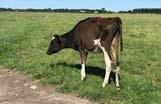
Navel infections
Infection of the navel cord often enters within the first 24 hours of birth. Infection spreads from the navel cord to the liver and the joints. Symptoms can include a hot swollen navel with discharge, progressing to painful joints that make it difficult for the calf to walk.
Treatment: Take a temperature for signs of an infection. Seek veterinary advice for treatment.
Prevention: Navel infections can be prevented by handling calves with care, avoiding trauma and bruising to the navel. Avoid over-crowding and provide soft/ clean bedding during transport. Avoid calves lying in wet/muddy conditions. Spray the navel cord with a minimum of 7% tincture iodine before pick up from the paddock, and again in the shed.
Calf pneumonia
Environmental factors such as low temperatures and high humidity, direct draughts, poor ventilation and a build-up of ammonia gas (poor housing), dusty environments, all can cause pneumonia or respiratory issues. A pneumonia infection can be acute (sudden onset), or chronic (long term). Signs include a dull calf, with a dropped head, a rapid respiratory rate, fever, nasal discharge and/or a cough.
Treatment: Take a rectal temperature and if elevated, it could mean the calf has an infection and needs an antibiotic treatmentseek veterinary advice without delay. A calf that is coughing and has a nasal discharge with no temperature can be a sign of poor ventilation and stale air and won’t necessarily need antibiotic help.
Prevention: Avoid having calves being cold and wet. Provide warm shelter and ensure enough nutrition is being fed to compensate for any energy loss from shivering. Ensure your shed has good ventilation. Ammonia smells at calf height will lead to respiratory issues.
Bloat
Abomasal bloat (right side distension):
Symptoms often appear within 1 hour of feeding, with death resulting from heart failure or asphyxiation 6–48 hours later. It is often due to overfeeding or abrupt diet changes, which encourages the growth of harmful bacteria (clostridia), where gas builds up and is unable to escape. This type of bloat cannot be relieved by stomach tubing to release the gas.
Ruminal bloat (left side distention):
Usually caused by delivery of milk into the rumen due to the oesophageal groove not closing, or overfeeding of milk which can be due to incorrect height of feeders, or worn teats. Normal rumen contractions decrease and belching to remove excess gas becomes impossible. This type of bloat can be relieved by releasing trapped gases via a stomach tube.
Vaccinations
Calves need to be vaccinated against a variety of diseases including leptospirosis –diseases depend on your local conditions. Vaccination against clostridial diseases is important for calves - 5 in 1 vaccines are available at your local Farmlands store. For other vaccinations such as Leptospirosis and Salmonella, contact your vet.

Disease management
Troubleshooting for other common problems
This table covers common problems that arise in New Zealand calf sheds.
Animal signs
Lame and/or swollen joints.
Coughing or noisy breathing and/or runny eyes.
Possible cause
Navel infection/joint ill, or injury.
Respiratory infection or pneumonia.
Shivering/shaking
A draughty shed or inadequate shelter from cold and wet conditions. Shaking during/ just after a milk feed could indicate that the calf is full.
Sunken eyes, dry gums. Dehydration.
Kicking belly/unsettled.
Not eating calf meal.
Abdominal discomfort caused by overfeeding or potentially a variety of gastrointestinal issues such as colic, bloat, ulcers, etc.
What to do
Seek veterinary advice. Careful handling when transporting and 7% tincture iodine can help to prevent this.
Increase ventilation, look into your shed health. Make sure bedding is dry. Seek veterinary advice for treatment.
Improve the shed facilities. Use calf covers. Ensure you are feeding warm milk and monitor feeding and avoid over feeding by using division feeders if possible for the first 2 weeks.
Ensure all calves have access to clean water. Scours could be the issue causing dehydration — feed Reliance Blue Boost electrolyte.
Check you’re not overfeeding the milk feed. If issues continue seek veterinary advice.
Stale or vermin/pest contaminated feed. Feeding too much milk or too much hay/fibrous feeds on offer.
Replace feed regularly. Get rid of feed that calves have slobbered over. Reduce amount of milk. Make hay harder for the calves to get at.
Disease management
Prior to the arrival of each batch of calves the calf sheds should be throughly cleaned and disinfected with a broad spectrum disinfectant. Pens should be frequently disinfected while in use also to prevent build up of disease organisms.
Virkon®S
Protect calves against disease
Virkon®S is the premium broad spectrum, on-farm, biosecurity solution. A highly convenient, fast-acting, one-stop disinfection package for surfaces, equipment, vehicles, aerial disinfection and water delivery systems. Virkon®S is proven to kill disease agents on-farm, even hardy pathogens such
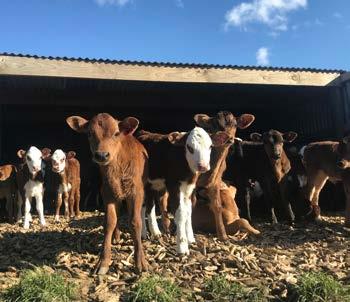
as rotovirus and salmonella in calf shed environments and is fully effective against all 18 families of viruses known to man – in addition to bacteria and fungi. Virkon®S is also proven to kill Mycoplasma bovis and is recommended by MPI.
Calf disease Disease Type Virkon™S effective
Rotovirus virus
Coronavirus virus
Salmonella bacteria
E.coli bacteria
Campylobacter bacteria
Mycoplasma bovis bacteria
Virkon®S is so effective and rapid acting (30 second - 2 minute kill time) that it is the disinfectant of choice for controlling exotic disease outbreaks internationally.
Unlike most disinfectants, Virkon®S does not use glutaraldehyde, which is chemically related to formaldehyde and shares the same dangers. Virkon®S can be misted in the presence of animals. Virkon®S is formulated to degrade naturally within the environment.
Usage information
Treat calf pens and equipment with Virkon®S at the beginning of the season before the calves arrive and continue treating calf pens and equipment regularly throughout the calf rearing season. Treat pens weekly/bi-weekly (depending on disease challenges).
There is no need to rotate with other disinfectants and it works in a range of temperatures and in hard water.
Calf sheds and pens
Dilution rate 1:100. Remove all moveable equipment and organic matter (mud, refuse etc.) and using either a pressure washer, knapsack sprayer or watering can, disinfect all surfaces (including in the rafters of sheds) with Virkon®S solution. Allow surfaces to dry before replenishing bedding and replacing equipment. Use the same dilution across all temperature ranges for airborne and surface contamination. Effective in cold temperature and through organic challenge.
Fogging/Misting
Dilution rate 1:200. Spray upwards with a fine nozzle and low pressure in the pens whilst calves are present to help reduce airborne pathogens. Safe to use in the presence of livestock.
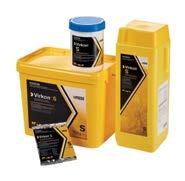

Milk feeding systems
There are many different early feeding systems used successfully by farmers, twice-a-day versus once-a-day, ad-lib versus restricted. When the performance of different feeds across early feeding systems is studied there is one common conclusion — a quality feed will outperform an inferior feed in any system.
Calf rearers should feel free to select the feeding system that fits in with the other things happening on their farm. Undeniably, when it comes to the choice of feed to use in your system, invest in quality.

System comparison
Twice-a-day feeding system
Higher milk usage: 40kg of calf milk replacer
Lower dry feed usage: 72kg of meal or more as required to reach growth targets
Higher labour costs: Two milk feedings per day
Lower animal health risk: More natural, lower stress to calf
Less infrastructure required: Outside rearing, less intensive farming`
Once-a-day feeding system
Lower milk usage: 35kg of calf milk replacer
Higher dry feed usage: 80-100kg of meal, or more as required to reach growth targets
Lower labour costs: One milk feeding per day at the same time each day
Higher animal health risk: Increased stress to calf. Preferably avoid starting OAD until calves are 3 week of age.
Intensive management: Indoor rearing, intensive farming, increased biosecurity risk, increased need to monitor and manage individuals
Accelerated Calf Programs
To achieve adequate growth rates, traditional feeding programs typically use milk replacers containing well balanced nutrients to provide energy and protein for growth, fed in combination with increasing starter intakes as a calf advances in age. With accelerated calf programs, young calves receive substantially more milk, milk replacer or milk fortified with milk replacer to support improved growth rates.
As well as improved growth rates, accelerated programs can help calves when faced with environmental and disease challenges. Calves on these programs do require close post-weaning management to successfully transfer them over to higher pasture diets. A good quality, palatable hard calf feed is essential to use and its important to encourage early intake of hard feed to assist rumen development.


Milk feeding
Top tips for milk feeding
• Ensure calves have received adequate colostrum in the first 4 days of life (see colostrum section).
• Whether you use whole milk or milk prepared from calf milk replacer, calves will grow better when fed milk at a temperature of around 38-39°C. Calves don’t thrive as well when fed cold milk, as cold milk requires more energy to digest compared to warm milk.
• Milk should be fed warm but not too hot. At temperatures above 60°C, proteins in the milk may become denatured and vitamins destroyed. Hot milk can cause calf discomfort and could interfere with the curd process.
• Ensure smaller calves get their fair share, watch out for bullying and ideally group slow drinkers together.
• Handle calves quietly and have a consistent routine, so that calves are more relaxed at feeding time.
• Avoid overfeeding as this can cause nutritional scours (see scours section).
• Ensure you have a stable supply of milk or calf milk replacer, so that the diet is consistent. Any changes must be gradual to avoid digestive upset. The gold standard for changing between calf milk supply (e.g. between different milk replacers or from fresh milk to calf milk replacer or vice versa) is to mix the old and the new milk at 50:50 for 3 days before moving fully onto the new feed.
• Compartment feeders are recommended for younger calves to ensure adequate levels of nutrition are being meet daily.
• Take care when preparing liquid milk. Ensure milk is mixed to the correct concentration and is mixing evenly. Milk that is too high in concentration may induce nutritional scours and milk that is too weak in concentration may be mistaken as water by the calf and therefore directed to the rumen rather than the abomasum, causing scouring and bloat (see calf milk replacer preparation section).
• Ensure all equipment used for feeding is cleaned regularly. Dirty equipment causes a build up of pathogens which can cause calf health issues.
Milk options
Calf milk replacer: It is essential that milk powder provided to calves is good quality. Milk powders should contain ingredients that have been selected for digestibility, solubility and stability for easy mixing in warm water and optimum digestion by the calf. Most importantly, the milk replacer must be palatable and meet all of the nutritional requirements for a calf.
Calf milk replacers can have benefits over using whole milk from the vat, as they include a range of additives lacking in whole milk, such as a coccidiostat (not in all calf milk replacers), plus vitamins and minerals, which can be present in whole milk at lower concentrations than are recommended for growing calves. They can also be more economical than taking milk from the vat and more consistent in relation to fat and protein content.
For more information on different milk replacer options, see page 35.
Whole milk: Whole milk from the vat, waste milk or milk from cows still within the restricted “colostrum period” (sometimes called transition milk), can be fed to calves. This milk is convenient as it is already in liquid form, however it can be more expensive to feed if it is milk that could have been sold, depending on the pay-out relative to the milk replacer price.
When whole milk is fed from the vat, often it is fed with less constraint compared to feeding a calf milk replacer that is mixed up more precisely for the number of calves being reared. Whilst calves may look well when fed on high levels of whole milk, they may struggle when weaned on to grass if they have been slow eating hard feed (see rumen development section page 40).
Whole milk from modern dairy cows is not always ideal for calves — it typically
contains more fat and less essential minerals, trace elements and vitamins than calf milk replacer.
If feeding whole milk to calves it is recommended to use a milk additive such as Reliance Level Up (see page 50) to balance out the deficiencies of the whole milk and ensure optimum health and growth of calves. Reliance Level Up also contains a coccidiostat to prevent coccidiosis.
Milk that is not fit for sale may contain antibiotics, which may affect the development of natural gut microflora. Raw milk could also carry Mycoplasma bovis and Johnes Disease. Internationally many dairy farmers pasteurise their own waste milk before feeding to calves, as they are worried about the possible transmission of diseases to the next generation of cows.


Fortifying cow’s milk
Using calf milk replacer
Calf milk powders can be used to fortify whole cow’s milk, which can be an effective way to increase the protein content of whole milk, reduce the fat content and add in vitamins and minerals that are often lacking in whole milk.
Whole milk is typically the equivalent to 125 grams of calf milk replacer powder per litre. This is important to keep in mind when adding calf milk replacer to whole milk, to ensure that you get the correct total amount of energy into calves.


Tip when using whey powder
When fortifying with a whey based calf milk replacer, do not add more than 250 grams of the whey powder to 4 litres of milk, as this can interfere with curding in the abomasum.
How do I mix in the calf milk replacer powder?
There are three options when mixing calf milk replacer in with whole milk:
1. Mix calf milk replacer at the usual rate of 125g/L with water (or at the rate specified on the bag), then add to the cow’s milk.
2. Mix the powder with a small amount of hot water before adding to the cow’s milk.
3. Introduce the powder directly into the cow’s milk and mix it well (watch out for blocked teats if doing it this way).
Options two and three can work well, as the resultant reduced volume of milk (due to the reduced amount of water added to the whole milk during the mixing process) will encourage the intake of hard feed and enhance rumen development.
Reliance Calf Milk Replacer
Reliance Calf Milk Replacer is a milk powder blend providing excellent calf response to the natural feed sources of milk fat, milk proteins and sugar. Contains the coccidiostat
1Bovatec®20CC (lasalocid sodium) to aid in the prevention of coccidiosis
Directions for use
Mixing ratio: 125g Reliance Calf Milk Replacer to one litre of water when fed twice daily, 250g Calf Milk Replacer up to one litre with water when fed once daily.
Dissolve Reliance Calf Milk Replacer powder in hot water (40-45°C), not boiling water. Mix to a creamy smooth consistency and add cool water to make up the required amount.
Feed at body temperature (38-39°C).
Mix only when required. Keep bag securely closed when not in use.
Feed after a good intake of colostrum has been achieved (from four days after birth). Ensure that reachable clean, fresh drinking water is available at all times. Ensure that calves have access to quality calf feed and restricted access to hay or straw. Keep buckets, bottles and other equipment clean.
STORAGE: Store between 10 and 20°C in clean, dry and vermin free environment.
Do not expose to direct sunlight and avoid contact with floor and walls.
1. Bovatec® 20CC is registered pursuant to the ACVM Act, 1997. ACVM Registration Number A009679. See www.foodsafety.govt.nz for registration conditions.

Ingredients selected from
Milk powder, vitamins (including A, D3, E, K3, B1, B2, B3, B5, B6, B12, ascorbic acid, niacin, pantothenic acid, Biotin), cobalt (organic), copper (organic), ferrous iron, iodine, selenium (organic), magnesium, manganese (organic), zinc (organic), dextrose, coccidiostat (Bovatec® 20CC), antioxidants, lecithin.
NOTE: Milk powder is casein based which typically curds but curd strength may be variable.
Typical analysis — Approximate on an as fed basis
Protein
Fat

Reliance Kiwi Power Whey
Formulated for calves from day 5. Premium, calf milk replacer (CMR) which benefits from NZ whey proteins – the major source of protein in colostrum.
Fortified with vitamins and minerals for optimal growth in addition to essential oils, a proven prebiotic, and organic acids. Contains highly digestible vegetable fat and hydrolysed wheat protein^.
Suitable for calves. Not all calves have the ability to curd, even high curding CMR. A whey-based milk powder does not need to curd and is well digested without curding.
^Hydrolysis of wheat protein improves digestibility by young animals.
Feeding recommendations
Always ensure adequate intake of good quality (high IgG) colostrum within the first 6-12 hours post birth (approximately 10-15% of its body weight) and continue feeding colostrum for first 4 days to boost the calves’ natural immune system.
As a guide, a 5-day old calf should receive at least 10% of its bodyweight daily as calf milk replacer (CMR). For example, a 40kg calf requires 4 litres of CMR per day. Feed a minimum of 500g Reliance Kiwi Power Whey per calf per day (unless at weaning stage).
When higher rates of gain are preferred, following the higher concentration rates of Reliance Kiwi Power Whey is recommended, (150g/L in a twice-a-day or 300g/L in once-a-day system).
When calves are suffering stress (e.g. disease recovery, environmental) it

is better to feed more litres than change the concentration.
If possible, when moving from whole milk or another milk replacer, transition over 3 days, Jersey calves are best fed on a twice-a-day regime until weaning, especially when not housed.
For best results feed a good quality feed such as Reliance Calf Grower 20% from day five along with limited access to conserved forage if necessary. Gradually transition to a pasture-based diet.
In a disease challenge situation, more coccidiostat (COCCISTOP® Premix) can be added at the treatment rate, as required. Always give constant access to chean reachable, fresh dringing water.
Ingredients
selected from
Premium whey proteins, highly digestible vegetable fat, hydrolysed wheat protein^, amino acids, vitamin and mineral premixes, acidifiers (organic and inorganic), prebiotic, essential oils, and Decoquinate (COCCISTOP® Premix). Designed and manufactured in NZ with domestic and imported ingredients. Do not use at the same time as any other selenised fertiliser, prill or product (apart from quality calf feed) without consulting a veterinarian.
Mixing
Mix Reliance Kiwi Power Whey with water (in rations per the applicable feeding program below) to make up to 1L.
Add the required amount of power to half the volume of hot water (48°C) and mix briskly for 1 minute. Top up with water to the required total volume. Mix gently and feed at 38–39°C.
NOTE: When foritying cow’s milk, do not add more than 50% of Reliance Kiwi Power Whey into whole milk as this can interfere with curding in the abomasum.
Mixing Example
To make 10L of Reliance Kiwi Power Whey at 150g/L concentration:
CALF AGE (DAYS)
Days 0-4
TWICE – A – DAY MILK FEEDING*
LIQUID PER FEED (LITRES, L) FEEDS PER DAY MIXING RATE OF POWDER (g/L) MILK REPLACER INTAKE PER DAY (GRAMS, g)
Colostrum: 250g (grams) of IgG within 4 hours after birth plus 15% body weight (maximum) in the first 24 hours. Feed to appetite for the remainder of the period.
Days 5-14 2.0L 2 125-150 500-600
Days 15-28 2.0L 2 125-150 500-600
Days 29- 42 2.5L -3.0L 2 125-150 625-900
Days 43- 56 2.5L 2 125-150 625-750
Days 57+Weaning 2.5L 1 150 375
*Twice-a-day feeding more closely matches the calves’ natural consumption and allows more opportunity to identify calves off their feed. A quality feed will out-perform an inferior feed in any system.
ONCE-A-DAY MILK FEEDING**
CALF AGE (DAYS)
Days 0-4
LIQUID PER FEED (LITRES, L) FEEDS PER DAY MIXING RATE OF POWDER (g/L) MILK REPLACER INTAKE PER DAY (GRAMS, g)
Colostrum: 250g of IgG within 4 hours after birth, plus 15% body weight (maximum) in the first 24 hours. Feed to appetite for the remainder of the period
Days 5-14 2.0L 2 125-150 600
Days 15-28 3.0L 1 200-250 600-750
Days 29- 42 3.5L 1 200-250 700-875
Days 43- 56 3.0L 1 200-250 600-750
Days 57+Weaning 2.5L 1 200 500
* Once-a-day feeding reduces labour but may require higher investment in housing and management.
Weaning
Wean off milk gradually, by reducing the volume fed rather than the mixing rate (dilute CMR is more likely to get mistaken for water and pass into the rumen) when 25kg above birthweight (typically 65kg minimum for Friesian calves) and when consuming 1 to 1.5kg per head per day of good quality calf feed such as Reliance Calf Grower 20% pellets. Help calves to transition to an all-pasture diet continuing to provide Reliance calf feed for one month or more after weaning from milk.

Preparing milk powder
Mixing
Work out how much calf milk replacer (CMR) powder you require to make up the litres of rehydrated CMR you need. For example, with a CMR that recommends a feeding rate of 125g/L, in order to make up 160L of rehydrated CMR you would need 20kg of CMR powder.
Amount of CMR powder required per feed (kg) = Number of calves x total litres of CMR per calf per feed x the recommended feeding rate of the CMR (g/L)/1000
The concentration of the rehydrated CMR is important, so make sure you read recommended feeding rates of products and calculate the amount you require per feed carefully. Add the required amount of powder to half the required volume of hot water (40-50°C) and mix vigorously using a whisk or a paint mixer until smooth (about 1 minute). Top up to the required volume of water using cool water so that the CMR is fed at 38°C - 39°C. Check the temperature before feeding.
An example of mixing up 160L of a 125g/L calf milk replacer
Water
Water temperature to dissolve CMR should be between 40°C - 50°C
Concentration (dosage CMR powder)
Too much CMR powder:
Too many nutrients = feeding diarrhoea (nutritional scours)
Perfect concentration: 20kg CMR powder = 160L finished CMR
Too little CMR powder: CMR in rumen instead of abomasum = bloat
Calf drinking temperature should be between 38°C - 39°C
Make sure you calibrate and check all measuring equipment regularly to retain accuracy. Also maintain strict hygiene practices and make sure any equipment used is cleaned between feeds.
How much should I be using?
A quick guide to how much milk replacer you should be going through in different calf rearing systems.
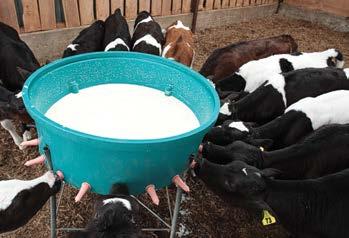

Nutrition and rumen development
The main goal of the calf rearing process is to develop the rumen of the calf in a short amount of time, so that when weaned it can get nutrients from eating high fibre feeds such as grass.
When a calf is born it is classed as a preruminant. The rumen is small (30% of the digestive tract) with the main stomach compartment being the abomasum. By weaning time, the rumen needs to develop from 30% to 70% of the digestive tract and be fully geared up for digesting grass.
In the mature cow, a large percentage of carbohydrates and proteins in pasture and supplements are digested by microbes in the rumen to produce volatile fatty acids (energy) and protein for use in maintenance, milk production or pregnancy. Calves are born with an undeveloped rumen and large abomasum. The large abomasum is important for digesting and obtaining nutrients from milk or milk replacer. It is essential that the rumen develops to become the main stomach where digestion takes place for a weaned calf.
Feeding a high starch calf feed from early in life helps to get the rumen working and can help to reduce unwanted behaviour such as naval and ear sucking.
Profitable and successful calf rearing relies on weaning the calf at the youngest possible age without hampering growth rates. This means the calf must be provided with the proper ingredients for rumen development, so it can utilise grass at weaning.
The following are needed for rapid rumen development:
A high quality calf feed that contains high levels of starch: Dry calf feed does not stimulate the closure of the oesophageal groove, so the feed is deposited in the rumen where it stimulates development. Starch promotes the growth of the population of rumen microbes and the development of rumen papillae, (finger-like projections that absorb nutrients). The longer and denser the rumen papillae, the more energy the calf will get from grass and pellets at weaning.
Hay or straw for effective fibre: Hay/straw promotes the development of the muscles that surround the rumen. This is important for encouraging rumen motility and feed movement around the rumen for digestion. A small amount of effective fibre is required for rumen development and rumination stimulation, however a large amount of hay/ straw can result in depressed hard feed intake and a large rumen size but with little papillae development. For this reason, make sure hay/straw is available to animals but don’t offer too much and make sure it isn’t too easy for them to over consume it (i.e. use racks that have hay/straw firmly packed in so they can pull little bits out at a time).
Clean water: Milk or milk replacer does not provide water to the rumen as it bypasses the rumen via the oesophageal groove when calves suckle. Water also helps to stimulate the intake of hard calf feed.
The water should be clean and fresh to reduce the risk of pathogens and disease. Water should be easily reached at calf height and make sure water availability matches calf requirements.
Weaning off milk
Use at least two parameters together when making weaning decisions for improved success and less of a post-weaning growth check. Wean calves from milk only when they are eating a minimum of 11.5kg of high quality pellets per day for a minimum of 3 consecutive days. Wean by weight rather than age.
Using scales or wither measuring sticks can be useful to ensure calves are ready for weaning. Be prepared to hold calves back if they are not meeting weaning weight targets. Although leafy young grass appears to contain sufficient crude protein, it lacks the by-pass protein required by calves lacking a fully functioning rumen.
Rumen development stages
Also, fresh grass is low in dry matter, which can limit dry matter intake due to the size of the developing rumen. Managing calf paddocks can be difficult. Avoid grazing very young leafy grass, which may contain excessive degradable protein for the newly functioning rumen to cope with. Offer straw at grass and continue feeding pellets to ensure a smooth transition to pasture and maintain target growth rates. Continuing to feed pellets at grass is particularly important for later born calves that need more feeding to catch up with early born calves but in reality get less because they are sent away to graze alone when younger.
Continue to feed calf pellets at grass for at least one month post-weaning off milk (ideally longer). This helps to maintain growth rates and protects calves against coccidiosis, which can often appear post-weaning. Feeding pellets beyond this stage can also be beneficial particularly if environmental conditions and/or pasture quality is poor.

Continuing growth post-weaning to mating
Calves that have been grown well up to weaning can slip behind growth targets during their first summer, autumn and winter if pasture supply is limited or pasture quality declines. Falling behind on growth targets can have an impact on the fertility of a calf when it comes to their first mating, as one of the main triggers of puberty is body weight rather than the age of an animal. If a calf does manage to get pregnant but is still struggling to reach growth targets, this can have a significant impact on the production in their first lactation as they will still have growth to catch up on post-calving and milk production will be sacrificed in order for the animal to continue growing.
Well grown animals with good muscle and skeletal growth will also be able to compete with older animals in the herd, whereas smaller, under-grown heifers may be bullied and miss out on their fair share of feed.
Summer can be a period of pasture deficit, as dry periods or excessive heat can limit pasture growth and encourage reproductive growth and reduced feed quality. Autumn can be a period of higher pasture growth but the pasture can often be lacking in sugar due to decreased sunlight, which can slow down rumen fermentation. Winter can be a tough time for calves, particularly if weather conditions are poor. In all of these situations calves may be struggling to meet growth targets, going through
periods of below target growth rates or even weight loss followed by periods of catch-up growth if pasture quality allows. This is an inefficient way to grow a calf and it is better to grow them consistently and to support lean muscle and frame growth and avoid fat deposition.
One way to ensure you continue to meet growth targets regardless of pasture quality or quantity and weather events, is to offer calves hard feed post-weaning through to mating when necessary — particularly if you notice that the calves are not putting on the weight that they need to. Feeding a pelleted feed during periods of poor pasture growth or quality will ensure that calves still reach growth targets and are well set up for a productive life. If calves cannot be weighed, height can be correlated to liveweight and provide a useful indication of how calves are doing.
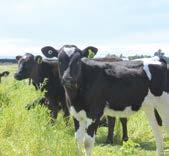

Only FeedSafeNZ accredited manufacturers may use the FeedSafeNZ logo on their packaging. The FeedSafeNZ mark assures farmers and animal owners that the feed they buy is made to the highest possible standard.
Top tips for feeding hard feed to calves
• Offer hard feed early. Calves may not eat much in the first few days but it will get them used to it and feed intakes will build with age. For the first 3 weeks it’s all about forming habits in calves, so intakes wont’ be huge, but it’s a training period to get them used to eating a hard feed.
• Always make sure fresh feed is put out for calves daily and that any older uneaten feed is removed. Uneaten feed left for too long can go mouldy and attract vermin. Calves will not eat feed that is stale, mouldy or contaminated by vermin. This is even more important when calves are first getting onto hard feed. For this reason, in the pens of young calves, put a small amount in the trough daily to begin with and increase from there.
• Clean troughs very thoroughly regularly, wet compacted fed provides a favourable environment for mould growth and can put calves off feed.
• Avoid dusty feeds — calves don’t like eating dusty feeds.
• Introduce calves to hard feed by feeding some by hand each day after their milk feed in the first few weeks of life. This will get them used to the flavour and texture and will also help to prevent cross sucking.
• Ensure reachable clean, fresh drinking water is always available to calves — a lack of water will inhibit dry feed intake and rumen development.
• Ensure unopened bags of feed are stored away from direct sunlight and away from possible vermin contamination in order to keep it as fresh as possible. Take the shrink wrap off pallets of calf feed as soon as it arrives.
• Ensure feed troughs are easily accessible to calves and there is adequate through space for the number of calves in pens.
• When feeding higher volumes of milk on a twice a day system calves will feel fuller for longer, this decreases hard feed uptake and slow rumen development. Alternatively, to decrease milk volume fed, look at using fortified or accelerated milk feeding programs.
• Ensure you are not to over feeding long fibre by restricting hay or straw through using feeders.
Hard feed quality checklist
Tastes good

NRM Products
TOP NOSH THRIFTY
Textured muesli style feed

20% protein pellet

16% protein follow-on pellet

16% protein pellet with PKE
For more details on the specs of products, check out the NRM website. www.nrm.co.nz

KEY FEATURES AND BENEFITS
• Starter feed with molasses to encourage early intake.
• Lucerne chaff improves texture and stimulates calf interest.
• Can be fed to older calves if desired.
• Contains a quality premix, a coccidiostat (Bovatec® 20CC) and essential oils - plant extracts that support gut function and dry matter intake.
• Contains 20% protein from quality protein sources for supporting muscle growth for young calves.
• High in grain for stimulating rumen development.
• Can be continued to be used post weaning off milk, particularly if pasture quality and/or quality is an issue.
• Contains a quality premix, a coccidiostat (Bovatec® 20CC) and essential oils - plant extracts that support gut function and dry matter intake.
• Perfect for Post-weaning support. 16% crude protein a good complement to high protein pasture.
• High in grain for continued rumen support.
• Good for calves on high quality pasture to continue to support growth post weaning.
• Durable pellets work well in paddock troughs and cone feeders.
• Contains a quality premix, a coccidiostat (Bovatec® 20CC) and essential oils - plant extracts that support gut function and dry matter intake.
• A lower priced option for use in situations where you many need to feed more or for longer on a fixed budget.
• Contains some palm kernel (up to 15%).
• Contains a quality premix and a coccidiostat (Bovatec® 20CC) but no essential oils.
• A good option for older calves when pasture quality/quantity declines over summer.

20% protein pellet


16% protein follow-on pellet
Calf 2000 SOUTH ISLAND ONLY For more details on the specs of products, check out the Farmlands website. www.farmlands.co.nz/Nutrition

KEY FEATURES AND BENEFITS
• Both contain 20% protein from quality protein sources for supporting muscle growth for young calves.
• High in grain for stimulating rumen development.
• Can be continued to be used post weaning off milk, particularly if pasture quality and/or quality is an issue.
• Both contain a quality premix and a coccidiostat (Bovatec® 20CC).
• Calf 2000 also contains a ‘GutBoostaTM’ prebiotic and essential oilsplant extracts that support gut function and dry matter intake.
• Perfect for post-weaning support. 16% crude protein a good complement to high protein pasture.
• High in grain for continued rumen support.
• Good for calves on high quality pasture to continue to support growth post weaning.
• Durable pellets work well in paddock troughs and cone feeders.
• Contains a quality premix and a coccidiostat (Bovatec® 20CC).



Reliance Level Up
Reliance Level Up is a comprehensive supplement designed to be added to whole milk (not Calf Milk Replacer) to help boost the health and vitality of calves from 3 days of age.
Level Up contains:
• Probiotic - a blend of live viable microbes which benefits the calf by improving the intestinalmicrobial balance, optimising digestion of feed and enhancing their health.
• Prebiotic – refined functional carbohydrates which support animal performance and well-being.
• An essential oil pack associated with increased dry matter intake and weight gain.
• The essential minerals sodium and magnesium which can be lacking in whole milk but are important for appetite.
• Seven essential trace minerals included at therapeutic amounts to support the health and vigour.
• Twelve vitamins known to be deficient on whole milk and often poorly produced within the pre-ruminantcalf that play key roles in appetite, disease resistance and vitality.
• Contains the specialist coccidiostat Decoquinate, which is a well proven aid in the prevention of coccidiosis.
Directions for use
Mix only when required. Mix vigorously into a small quantity of warm whole milk before adding and stirring thoroughly to the batch of milk just prior to feeding. Agitate the milk to remix if left standing for some time. Feed at body temperature (38-39°C).
Do not add to mineralised calf milk replacer

or supplementary feed. Calculate the daily amount required based on the number of calves being fed per batch of milk. If milk is fed twice per day ideally deliver half the daily amount in each feed. Wash hands thoroughly after use. Ensure that clean drinking water is available at all times and that calves have access to quality calf feed and restricted access to hay or straw. Keep buckets, bottles, and other equipment clean. Wash hands thoroughly after use.
Dosage
Administer 10g/calf per day to fortify the equivalent of 6L of whole milk. For calves below 40kg, a feeding rate of 7g/calf per day should be used. For best results feed every day with milk through until weaning.



BOUNCE BACK WITH




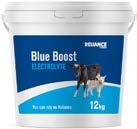


Calf rearing shopping list
Good quality hard feed, e.g. NRM and Reliance
Disinfectants, e.g. Virkon®S
Adequate meal troughs and water troughs
Hay racks
Rodent and bird control
Thermometer (rectal and one for calf milk)
ID neck ties
Colostrometer or refractometer
Replacement teats
Calf feeders, e.g. Stallion or Milk Bar
Milk mixing equipment and utensils
Measuring stick/girth tape/scales
Coccidiostat for milk if using whole milk
Colostrum/milk tubing equipment
Milk warmer if using whole milk
Electrolytes e.g Reliance Blue Boost
Iodine spray/dipping cup
i.e at least 7% tincture iodine/spray bottles/dipping cup
Spray marker
Disposable gloves
Calf covers
Ear tagger and tags
Metabolics for the cows
Notebook
Wall chart
Vet supplies, e.g. antibiotics, anti-inflammatories
Bedding
Sprayer
5 in 1 vaccinations
Combination worm drench and faecal egg testing kits, e.g. FECPAKG2 kits.
Farmlands Calf Rearing Guide
Recycle Me
Any bags with the Recycle Me Logo are made from woven polypropylene that:
• Provide excellent protection against moisture and pests compared to paper alternatives
• Are strong enough to be transported and used on farms
• We have lowered the carbon footprint than our previous bags by using 25% less plastic per bag.
• Are recyclable through Agrecovery
Scan QR below for more information.

